Reported Aircraft Down In Your 1st Due: Would you know what to do?
Following are some tactics to employ and pointers. I am no ARFF(Airport Rescue Firefighting) expert or ARFF instructor, but I am an ARFF certified firefighter. And I encourage anyone with ARFF experience to contribute to this thread. As well as those with none, ask questions, I'll answer them to the best of my ability, if I can.
You can usually expect one of two things when responding to the report of an aircraft down. One, the aircraft simply made a hard landing and the fuselage is intact, resulting in anything from slight injury to crew and passengers, most being walking wounded, to severe trauma and/or death. Or, two, the aircraft has crashed and you will encounter complete, total and utter carnage, with the probability of survival being minimal. In this case, you will most likely find body parts instead of whole people. Be prepared to see the worst. CISD will need to be employed.
Examples of a hard landing:
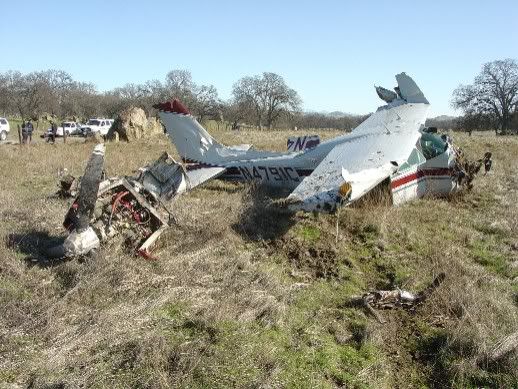
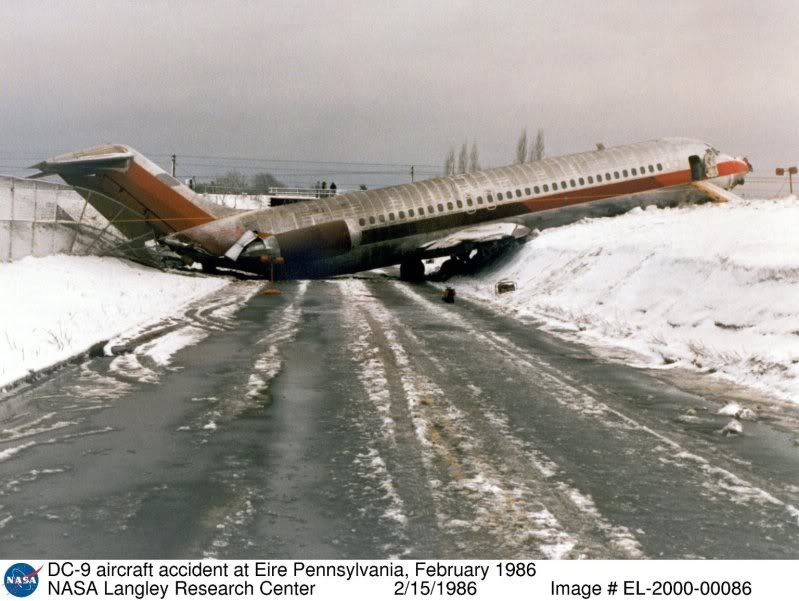

Examples of a crash:
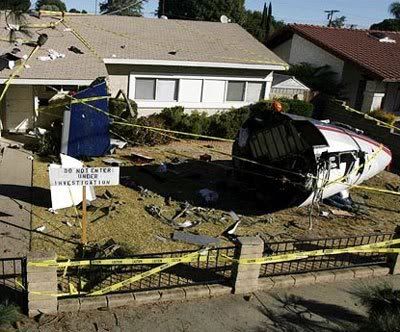
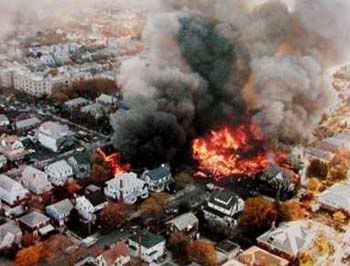
Do not move any pieces of the aircraft unless you absolutely have to, to necessitate a rescue. It needs to be treated as you would a crime scene.
If you encounter an aircraft down with the fuselage intact, with fire involvement, time is of the essence. Burn-through time on aluminum fuselages is usually less than 1(ONE) minute. Make sure you wear your SCBA! Many aircraft today are made with composite materials, as well as aluminum. Composite materials are a known cancer causing agent. Aircraft fires will involve large Class B fires. Class B foam or AFFF will be required. Set up apparatus and attack the fire at a 45º angle from the fuselage, on both sides of the aircraft. A rescue path needs to be cut, and maintained at all times, toward the fuselage with handlines, using the roll-on method to apply the foam.
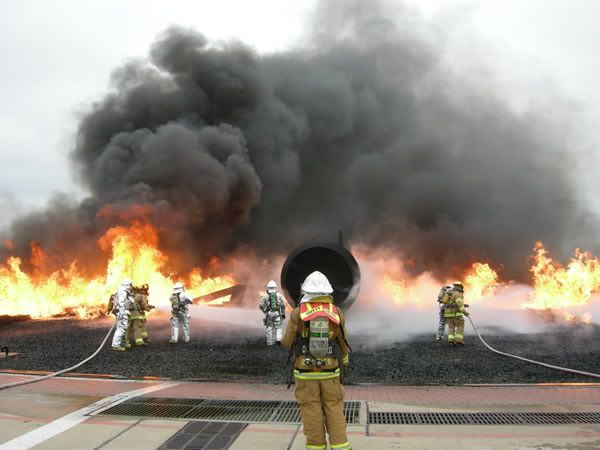
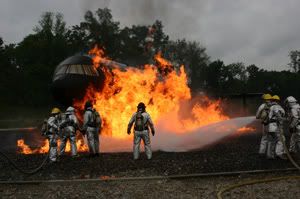
Once you reach the fuselage you need to make entry. Remember, just like a vehicle crash or forcible entry into a structure, try before you pry. Most aircraft doors are clearly marked with easy instructions on how to open the door.

Employ ground ladders, place them directly at the door. Or if there are emergency escape doors over the wing place the ladder as close to the fuselage as possible with the top of the ladder over the wing as you would a structure, two or three rungs. A K-12 saw with a carbide tipped blade is best to use, warthog blades work well, too.
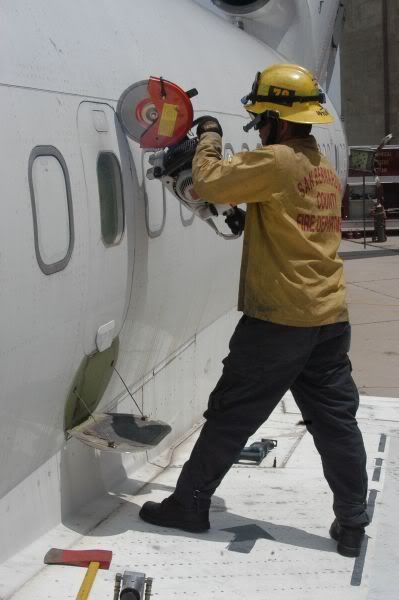
Employ a piercing nozzle if you have one, flood the fuselage passenger compartment, it will buy you time and hopefully keep those inside alive. Foam is not necessarily needed in this instance.
If you encounter an engine nacelle fire, flood the engine. Be very cautious and aware of jet engine intakes and prop aircraft propellers. Approach at a slight angle and keep your distance until the engine has shut down. If the pilot is unable to shut the engines down flooding the nacelle will do so.
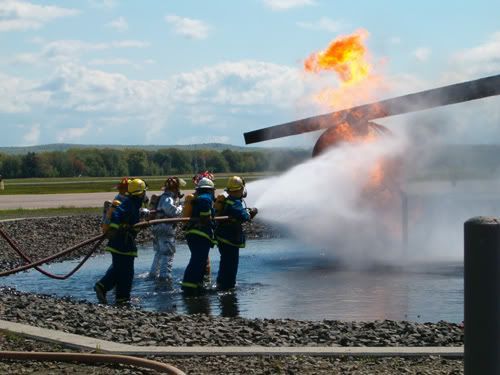
If you encounter an aircraft crash where the fuselage is intact with no fire, but leaking fuel, apply and maintain a thick foam blanket, and take away all ignition sources.
Think big picture, don't hesitate to call for mutual aid and upgrade your alarm. If it's a large aircraft activate an MCI immediately. You will need lots of foam, and lots of manpower. As well as your regular mutual aid, airport and military ARFF units are more than willing to respond and help out. They have the apparatus specifically designed to deal with this type of emergency. Though the ARFF truck is much larger than our normal engines and ladders, they are small enough to drive and navigate city streets and country roads. And they're agile enough to go where our engines and ladders can't, into the wilderness.

Lastly, train with them. Most commercial airport and military airbase ARFF units are more than willing to offer classes and hands on training.
Tags:
Replies to This Discussion
-
Permalink Reply by DUST on January 22, 2010 at 6:57am
-
Good posts...another thing to be careful of are small, lightweight aircraft with ballistic recovery systems. We have several Cirrus planes that have them at our airport. Basically, they have a parachute that shoots out and lowers the plane to safety if it has an emergency . Great for pilots but could be bad for the firefighter responding to one that is downed without the parachuting having deployed. Kinda like an undeployed airbag on crack! You can go to the Cirrus website and download the advisory movie for first responders or ask them to send you one like I did. Good training.
www.cirruspilots.org
-
Permalink Reply by Oldman on January 22, 2010 at 8:56am
-
Excellent point. While Cirrus is the main company utilizing this system, BRS are being evaluated and approved for other aircraft manufacturers such as Cessna.
-
Permalink Reply by Smoke Eater on January 23, 2010 at 1:10am
-
Doug all I can say is, WOW!!! You done one hell of a job putting this together. It is very useful information to me as I have never had a class on aircraft firefighting. I really appreciate this type of posting. Thank you very much!!!
Take care and stay safe brother!!!
-
Permalink Reply by Doug on January 23, 2010 at 9:00am
-
Thanks for all of the replies, everyone. I know there's ARFF guys on this site, and those interested in it, but I wasn't sure how this thread would be received. So, I'm glad to see quite a bit of involvement from you guys. Keep up the good work.
-
Permalink Reply by Ron Ayotte on February 7, 2010 at 11:01pm
-
Doug.. nice job!
We have a small privately owned GA airport, two helipads and 11 designated landing zones for aeromedical helos in my community. We are also in the approach and departure paths for Hanscom Field (corporate jets and GA aircraft) and Logan International Airport (everything from corporate jets to A340's and 747's)
Most of our aircraft incidents occur at or around the airport (9B1) and involve small aircraft and transient pilots unfamiliar with the airport. It has a 1600 foot runway with one approach over trees, the other over a road. Add the crosswind component, it can get a little hairy.
We do train at the airport for aircraft incidents; the airport manager was a USAF ARFF firefighter back in the day.
-
Permalink Reply by Jim Price on July 29, 2013 at 10:43am
-
As a follow on to the General Aviation (GA) discussion, it's not just Sirrus aircraft with Ballistic parachutes, they are being retrofitted onto other GA types, including Cessna. Another concern is the introduction of Airbags on to aircraft. Sirrus has many of the airbag equipped units out there, but again, being retrofitted to others. Ther is no placard to warn you, and they are not in the dash/instrument panel. They are contained in the lap belt/shoulder harness. If they look like a regular seat belt, flat no airbag. But if they are "fat" or look heavily padded, there is an airbag to deal with...so no seat belt cutters there. See attached pics for examples from the FAA CAMI in Oklahoma City.
- Attachments:
-
-
 DSCF5644.JPG, 820 KB
DSCF5644.JPG, 820 KB -
 DSCF5646.JPG, 841 KB
DSCF5646.JPG, 841 KB -
 DSCF5647.JPG, 830 KB
DSCF5647.JPG, 830 KB
-
-
Permalink Reply by Jim Price on July 29, 2013 at 2:40pm
-
And concerning aircraft training DVD's, you can ask your FAA regional Airports Division to send you the ARFF training DVD's...those are free as well. Just go to FAA.gov and click the AIRPORTS tab and look under safety.
-
Permalink Reply by ashfire on July 31, 2013 at 9:54pm
-
Years back I took some weekend classes though MIFR and U.S. Air Force for the local fire services to give everyone and idea what to deal with any aircraft crash. Many were told don't touch, flag, tape off, do what you can until the State Police, FAA, Military arrive. Report what you had to do, who was involve. I had a vol capt helping a owner of a aircraft at a crash collecting items from the aircraft that hit a house. Only thing that stopped them was the state trooper that told them to drop everything where it was and get away from the aircraft.
-
Permalink Reply by ashfire on August 1, 2013 at 8:29pm
-
I meant to say MFRI instead of MIFR. Concerning aircraft in my area we have two small airports in our response area in less than 10 min from our station. Plus Andrews Air Force Base and airliners over our area in or out of Reagan National Airport. Since 9/11 most of the aircraft out of the two small airports has been restricted because of the distance to Washington DC.
The incident I told about was a aircraft left the airport started to have problems and hit a house in line with runway within a quarter of a mile. The thing is that the airport was there first and the housing boom people thought it would be great to build a street with $200,000.00 homes over a berm in line with the runway.
One incident had a plane going in the other direction of the same airport but crashed in the woods between the airport and a local road. Two survivors got out the plane and went in different directions for help, one toward the road and the other back to the airport. The pilot died when the aircraft caught fire. The problem was no access to the site of the crash except by foot and dragging and carrying equipment there to put out the fire. There have been a number of crashes between the two small airports and a few I know of at or near Andrews.
-
Permalink Reply by Paul Frenzel on November 27, 2013 at 6:09pm
-
As for my city ( population fo 200,000) I'm not sure wheather the first units arriving on scene would really know what to do in case of a plane crash - when I describe my city, I can always say "the city has everything - except for a zoo and an airport", and yes, it really is like that: ecept for these two things I can't imagine anything we don't have - name sth and it's very loikely that we have it ^^
Also if there's no airport, besides rescue helocopters landing at the hospitals, there still are some planned helicopter landings (e.g. politicans or the pope) which have to be secured by fire trucks on stand-by. In case of a passenger plane crash it would be an alarm raching out over several counties: In my city we have a paid FD with one big station, 5 volunteer FDs with 11 stations and 3 factory FDs. The next paid full time FD is more than an hour far away (calculating with the speed of cars, not (fire) trucks).
Nearby my city there is an airfield, but that's part of a U.S. Army Garrison.
Some fire departments train plane crashes in a really LARGE scale. Thus there was a plane crash drill conducted at Frankfurt International Airport few years ago. The simulated scene was a crash between two passenger plains, which means 500 injured people. Of course that was a MCI alarm immediately. And as I said: it was a large scale drill: 400 emergency vehicles with all 1500 emergency crew members responded to the crash scene and simulated not only the extrication of the victims, but also the transport to the hospitals which have to be able to take delivery of that amount of patients
Here's a video of all arriving and leaving emergenc vehicles for that MCI drill with 500 victims:
-
Permalink Reply by Nic on August 23, 2022 at 4:25pm
-
Hey, Doug, what an informative post on ARFF (Airport and Rescue Fire Fighting). I really liked the insight you provided into this type of firefighting and the involved agencies. Of course, the National Transportation Safety Bureau (NTSB) and Federal Aviation Agency (FAA) are heavily involved in these types of operations and include extensive regulation enforcement. As a private pilot certificate holder myself I know a little about some of the NTSB reports needed and response to a down aircraft etc. While I’m currently a student in the Emergency Service Administration program at Arapahoe Community college and a flight school student (pursuing an airline career) I do find this type of emergency service work very interesting. I work at a Fixed Based Operator at my local airport which is one of the busiest in the country! I have a lot of family in the fire fighting career and including friends. I have always been interested in ARFF trucks, especially seeing them doing routine exercises at the airport I work at (Centennial, CO) and where I grew up (Kauai). I really love the complexity and details involved with this type of fire fighting and responding to aircraft fires.
I have included a few articles.
The first one is in which a younger passenger was run over by an engine. I “believe” but am not sure of all the details involving the incident. What I understand is that she was covered in the filming foam and ran over and was later pronounced deceased at the scene. It is an important illustration of the use of filming foam and what to look out for on the scene. Here is the link for more details: https://www.mercurynews.com/2018/07/06/firefighter-said-s-happens-after-girl-run-over-at-sfo-in-2013-asiana-crash/
I also found this article on the regulation of firefighting foam interesting. Check it out:
Lastly, there are a handful of details involving incidents with foaming suppressants. Here is one: https://www.youtube.com/watch?v=9rAV8jqbEME
I think that the use of foam can be extremely useful but it is important to how it is accomplished including policies and best practices. I hope I could add some type of contribution to the discussion in some way.
*Disclaimer I am only a student and have no experience within the emergency service field or ARFF.
- ‹ Previous
- 1
- 2
- 3
- Next ›
Specialty Websites
Find Members Fast
Firefighting Videos
© 2026 Created by Firefighter Nation WebChief.
Powered by
![]()
Badges | Contact Firefighter Nation | Privacy Policy | Terms of Service